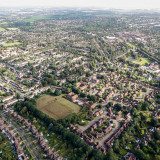It’s been a while since my last blog – with Covid-19 and lockdowns having quite an impact on the way we are all working. Here at the International Garden Cities Institute there has been a more virtual approach to garden city research in the latter part of 2020 since September but there are some interesting things to report nonetheless.
It was wonderful to have the opportunity to host Letchworth Garden City Heritage Foundation Executive Director for Stewardship and Development, David Ames to work with my Sustainable Planning masters’ students in October 2020 to explore the history, contemporary practice and possible futures of garden cities in planning and placemaking terms. The focus was on Letchworth Garden City but with wider lessons in relation to the resonance of garden city principles and practices today. David led us on a fascinating virtual field trip and the discussion with students was particularly lively and engaging. It was clear that today’s sustainable planning students see garden city principles as a living tradition with much to teach us about how to make places well for health and other forms of resilience. Students were particularly interested in the interplay between garden cities as places – their design and architecture – and the more process based aspects including long terms stewardship, governance and economics with particularly reference to the land value capture model at the heart of the garden city.
Looking more broadly at cities today, one aspect that the Covid-19 pandemic has put into sharp relief is the inequality between those who have good access to private gardens and public green space and those who do not. This gardens aspect was well represented in garden cities’ planning from the start. Large private gardens were and remain a feature for many but are not now and have never been the only way in garden cities to ensure access to green space and the benefits it brings – many different forms of green space access have always been embedded in the garden city model. In fact the importance of green streets and parks is also emphasised in garden cities historically as well as in the current circumstances.
This is not a ‘garden cities good, other cities bad’ situation. Many cities have superb green space elements and design ideas emphasised in garden cities also have retrofit potential in other cities and suburbs. This is something I reflected on while reading a series of news reports since the start of the pandemic about an argued move out of cities as people ‘up sticks’ to places in or nearer to rural areas to reap the benefits of proximity to the countryside. One of the ironies is that many of these out-migrators are moving to low density, car dependent places so adding to the climate change burden on the very countryside they crave connection to. Garden Cities by contrast have at least in principle the capacity to better allow for that very understandable craving for gardens, parks and the countryside in a more considered and egalitarian way that doesn’t have the same downsides for wider society and the future.
Of course the aspiration for excellent, fine grained interconnection between housing and green space is not always matched in reality. I reported in my last blog published in August 2020 on the gap between garden city principles and actual practice in a range of current proposals and examples of new self-defined ‘garden’ settlements being developed around the UK. It is timely therefore that in September 2020 the Town and Country Planning Association released a new practical guide on sustainable transport for garden cities.
Among its overarching elements the TCPA Practice Guide on Sustainable Transport are principles related to location and connectivity; the need to set an overarching vision, focused on delivering sustainable transport; the crucial need for collaboration; the recognition that sustainable transport systems must be inclusive and transport must be future-proofed. Strategic planning and design are also covered, with principles that Local Plans should establish mode share targets and networks; build to the right density; apply a user hierarchy; consider key design features and integrate green infrastructure and climate resilience within transport design.
The ‘garden’ focus of garden cities housing and streets has also been a critical context and inspiration in view for work by today’s designers. Last September, The Guardian newspaper asked four architectural firms to come up with ideas in response to the pandemic and Foster and Partners proposed the idea of ‘garden streets’ – something that garden cities have in fact instituted since they started. In this proposal the designers argue, “Why not transform streets into “miniature greenbelts” surrounding homes, thereby improving our health and reducing the strain on hospital services? By centralising bins (as in some European cities), planting trees and adding furniture such as benches, as well as restricting car parking and through-traffic, you give people room to gather, children room to play and generally use small-scale interventions in public life to make a big impact.” Read the full article here.
One of the useful things about this proposal of course is that it does not rely on private gardens but instead on sharing public street space in more sustainable and equitable ways that give space to people rather than car storage. It makes the point that ‘Many cities lock most of their green space into private gardens, in effect planting inequality into the built environment; meanwhile, roughly 65% of the public realm in the UK is dedicated to vehicles yet 80% of the time cars are static. Front gardens are occupied by bins and there is often nowhere public to socialise and relax.' (op cit.)
It is worth pointing out that, although well argued for in this proposal, ‘garden streets’ aren’t really a new idea – many designers have previously explored green streets. Close to home, edible streets ideas such as those that the IGCI has been involved in through the Edible Cities Network research programme – have been exploring how to reclaim streets for people for some years. That has been given more recent impetus by developments of Low Traffic Neighbourhoods; themselves in part in response to Covid-19 and the urgent need identified to enable walking and cycling locally as fast as possible.
Well that’s it from me for now. I will look forward to reporting in again in a few months’ time when I hope the pandemic news will be more positive. The wonderful advent of vaccines is promising better things to come and I want to wish everyone a safe and healthy 2021.
Associate Professor Susan Parham
International Garden Cities Institute
January 2021

